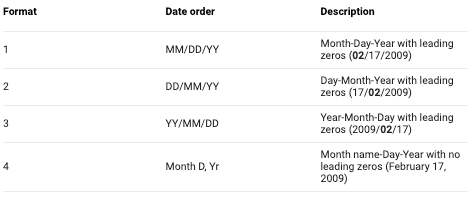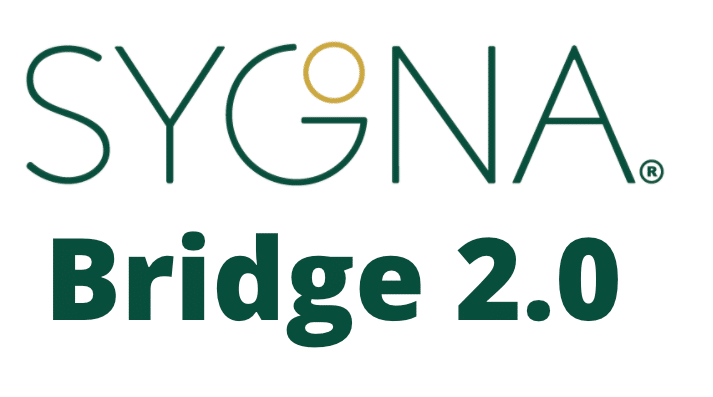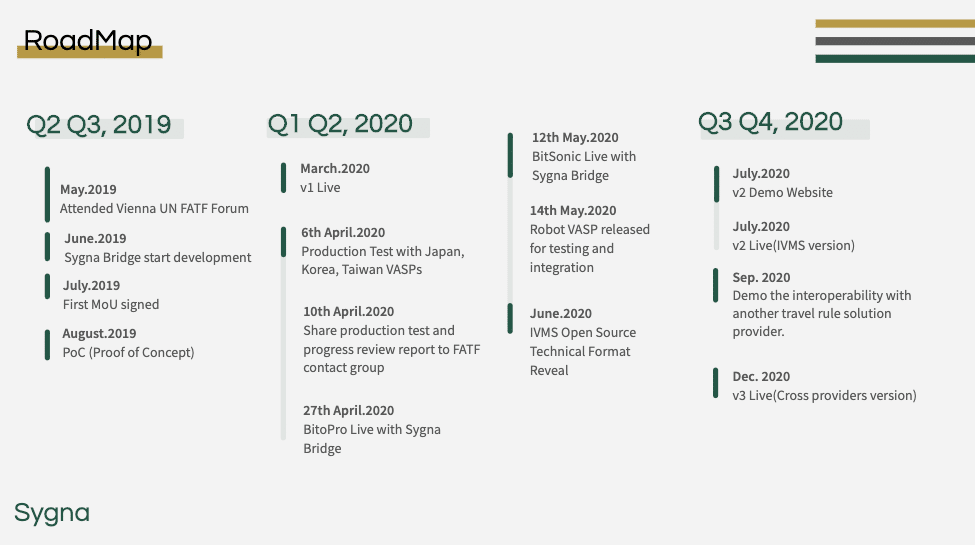Table of Contents
- Introducing Sygna Bridge 2.0
- What is IVMS101?
- Why IVMS101 is important
- Why did Sygna Bridge adopt IVMS101?
- How Sygna Bridge 2.0 supports IVMS101
- Sygna Bridge’s Open Source Code Generator
- What’s next for Sygna Bridge and IVMS in 2020?
- Sygna Bridge 2.0 Release Notes
Introducing Sygna Bridge 2.0
Blockchain security and compliance company CoolBitX has released Sygna Bridge 2.0, the latest version of its “FATF Travel Rule” solution for virtual asset service providers (VASPs).
Sygna Bridge 2.0 also supports the InterVASP Messaging Standard (IVMS101), the Joint Working Group’s unifying messaging standard, and comes after months of technical improvements and rigorous testing with VASP partners in Japan, Korea, and Taiwan.
CoolBitX launched Sygna Bridge in 2019 as a first-to-market “FATF Travel Rule” technical solution to help VASPs comply with the Financial Action Task Force (FATF)’s updated Recommendation 16 data-sharing requirement.
Sygna Bridge 2.0’s adoption of IVMS101 is significant as it marks one of the first actions taken by a technical solution provider (TSP) in the crypto-asset industry to ensure that its Travel Rule network data is cross-compatible with that of other providers.
This follows Sygna Bridge’s May 2020 production report in which CoolBitX shared with the FATF Contact Group proof of its successful Travel Rule data transfers between leading exchanges SBI VC (Japan), Bitsonic (Korea) and BitoPro (Taiwan). The report was audited and verified by a Big Four accounting firm.
What is IVMS101?

The InterVASP Messaging Standard (IVMS101) is the Joint Working Group (JWG)’s unifying language standard to help TSPs and VASPs share consistent and accurate originator and beneficiary transmittal data.
The Joint Working Group (JWG) is an influential alliance of blockchain industry bodies IDAXA, the Chamber of Digital Commerce (CDC) and Global Digital Finance (GDF) that convened online weekly in 2020 to help the crypto industry respond to the FATF’s challenging new anti-money laundering (AML) and combating-terrorism-financing (CFT) regulations.
In early May 2020, the JWG unveiled the result of this collective effort, the InterVASP Messaging Standard (IVMS101).
Why IVMS101 is important to the crypto industry
IVMS101 is the first successful crypto industry-wide effort to unify Travel Rule compliance services and make them cross-compatible. This is an important achievement.
Most VASPs will likely interact with more than one Travel Rule solution used by a counterparty VASP during virtual asset transmittals, due to daunting linguistic, jurisdictional and cultural challenges associated with implementing the Travel Rule across the FATF’s 200+jurisdictions.
For example, there are huge linguistic and date order variations across English-speaking countries alone, and it gets worse when dealing with VASPs in Asia, Europe, and the Middle East.
Example 1: Date format
To illustrate, how would the date 5 July 2020 be recorded around the world? Here are 3 versions:
- United States: The date begins with month, then day, then year (MM/DD/YYYY)- therefore, 07/05/2020
- Most other countries: The date begins with day, then month, then year (DD/MM/YYYY)- therefore 05/07/2020
- Some other countries: In China, Korea, and Iran, the date begins with the year, then month, then day. (YYYY/MM/DD)- therefore 2020/07/05.

Example 2: Name Variations
Uniformly romanizing (transcribing to English) people’s names is a long-standing problem in countries that use non-Latin alphabets, such as Cyrillic (Russia), Hanzi (China), Kanji (Japan) and Hangul (Korea).
IVMS101 helps to bridge these issues by ensuring that participant TSPs incorporate a fixed set of data formats into their offerings.
Why Sygna adopted IVMS101
For CoolBitX, the creator of Sygna Bridge and the CoolWallet S hardware wallet, its mission since its inception in 2014 has remained a constant: Making virtual assets safer and easier to use.

As a pioneering Travel Rule solution provider with an expanding footprint in Greater Asia, CoolBitX’s senior team members convened frequently with the JWG from January until May.
CoolBitX was a founding supporter of IVMS101 when it was unveiled on 7 May 2020, and pledged to support the messaging protocol as soon as possible with its Syna Bridge API. This is a promise the development team has now delivered on.
How Sygna 2.0’s IVMS support works
Sygna Bridge 2.0 has an open-source code generator that will enable VASPs to develop their IVMS101 data format with ease, and with multiple programming languages (Java, Javascript, Python, Ruby on Rails).
For a full technical breakdown, please visit CooBitX’s Github page.
IVMS Support Key Points
- A data set will contain personal user information and also comply to IVMS101
- An open-source code generator will help construct these data sets, thereby removing the need to manually create this data structure.
- VASPs only have to assign the information to the object for the code generator to create the data sets
- Sygna will help VASPs construct the data format. When it changes, the VASP only needs to update to the latest version, not rewrite the code.
This should really simplify the process for VASPs.
Sygna Bridge’s Open-Source Code Generator
The repository is still pending at present. CoolBitX will update this article once it has been released on our GitHub page.
What’s next for Sygna Bridge and IVMS in 2020?
Building an IVMS101-compatible technical solution is only half the challenge for TSPs like Sygna Bridge. Next up is implementing and testing it in practice.

CoolBitX will continue to promote the adoption of IVMS globally, by collaborating with other TSPs to establish Proof-of-Concept (PoC) data that validates the live implementation of IVMS101.
CoolBitX will implement these improvements in Sygna’s V3.0 product release later in 2020.
Sygna Bridge v2.0 Update Notes
- IVMS101 – Sygna Bridge now supports the IVMS101 data standard to facilitate the sharing of compliance information across networks.
- Version code – The new version code is formatted into two digits. One major and one minor code. For example: v2.0, v2.1 and etc.
- Beneficiary/TransactionID – After the blockchain transaction has been executed by Originator VASP, Originator VASP should upload the transaction ID (transaction hash) to Bridge Server. Bridge Server will relay the information to Beneficiary VASP via the new API.
- Error Code update – There are three new error codes updated.
- API endpoint update – For example, the path is changed from https://test-api.sygna.io/sb/api/v1.1.0/bridge/vasp to
https://test-api.sygna.io/v2/bridge/vasp. - New IP address – For test environment: 18.176.184.195 and 18.176.189.141.
- Address validation – A new option for Originator VASP to check if the beneficiary has the wallet address before the personal information is sent to beneficiary VASPs. You can activate this function In the Bridge/PermissionRequest API with need_validate_addr parameter to truth.
- Currency ID – Bridge now supports most smart contract tokens.
- Transaction – New transaction data format in the following API: Bridge/PermissionRequest and Beneficiary/PermissionRequest.


